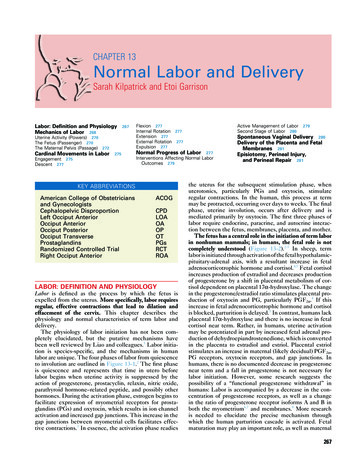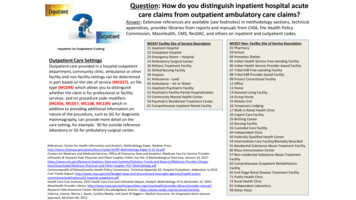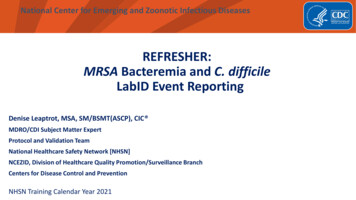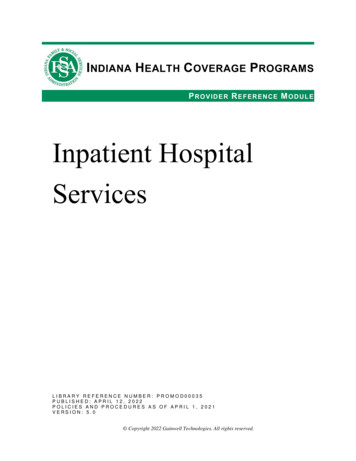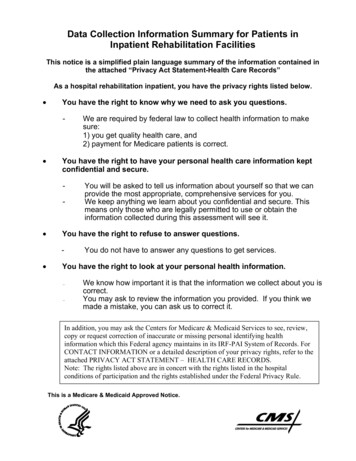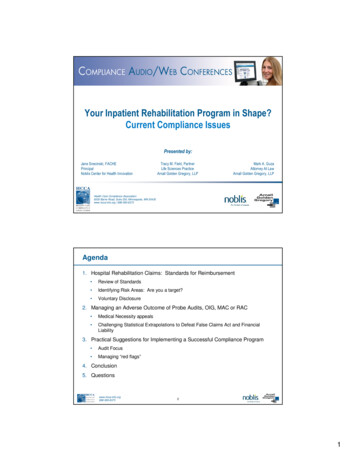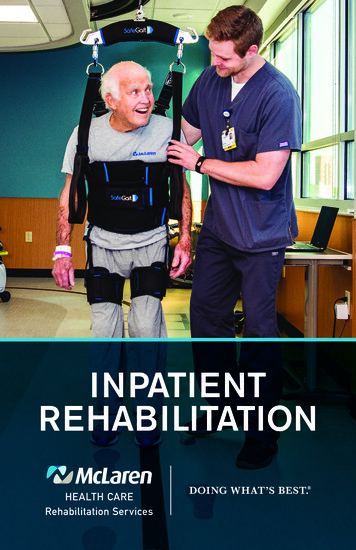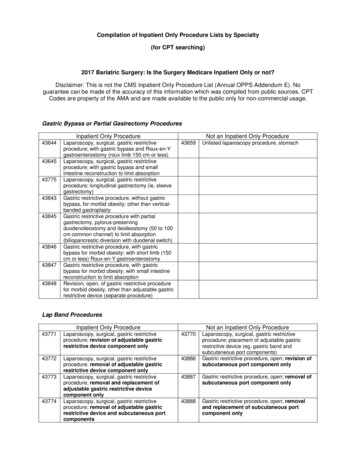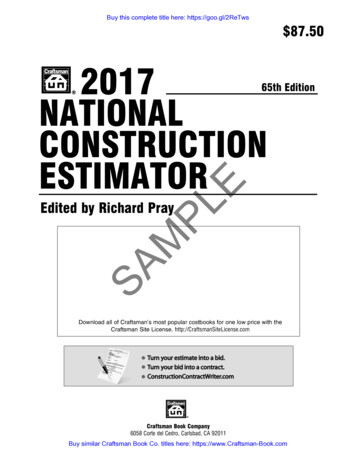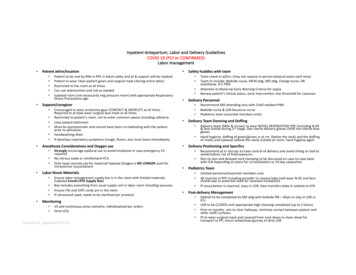
Transcription
Inpatient Antepartum, Labor and Delivery GuidelinesCOVID 19 (PUI or CONFIRMED)Labor management Patient attire/location Support/caregiver Strongly encourage epidural use to avoid intubation in case emergency CSrequiredNo nitrous oxide or remifentanil PCAOnly nasal cannula use for maternal hypoxia (Oxygen is NO LONGER used forintrauterine resuscitation)Labor Room Materials Encouraged to wear protective gear (CONTACT & DROPLET) at all times.Required to at least wear surgical face mask at all timesRestricted to patient’s room, not to enter common spaces including cafeteriaUses patient bathroomMust be asymptomatic and cannot have been co-habitating with the patientprior to admissionHandwashing oftenIf develops respiratory symptoms (cough, fevers, etc) must leave immediatelyAnesthesia Considerations and Oxygen use Patient to be met by RNs in PPE in Adult Lobby and pt & support will be maskedPatient to wear clean patient gown and surgical mask (during entire labor)Restricted to the room at all timesCan use telemonitors and tub as neededIsolated room (not necessarily neg pressure room) with appropriate RespiratoryIllness Precautions signEnsure labor management supply box is in the room with limited materials(Labeled Covid /PUI Supply Box)Box includes everything from usual supply cart in labor room including vacuumsEnsure FSE and IUPC cords are in the roomIf ultrasound used, needs to be sterilized per protocolMonitoring VS and continuous pulse oximetry, individualized per ordersStrict I/Os Safety huddles with team Delivery Personnel Limited personnel/essential members onlyAll must be in PPE including provider to receive baby (will wear N-95 and faceshields due to potential need for neonatal intubation)If resuscitation is required, stays in LDR, then transfers baby in isolette to ICNPost-delivery Management Version 10 Updated 6/15/20Recommend pt in stirrups to have control of delivery and avoid sitting on bed toavoid/reduce risk of fluid exposure.Skin-to-skin and delayed cord clamping to be discussed on case-to-case basiswith ICN depending on plans for co-localization vs 14-day separationPediatrics Team Delivery team (MDs & ndnurses) to wear NOVEL RESPIRATORY PPE (including N-95& face shield) during 2 stage. Don sterile delivery gloves OVER non-sterile blueglovesHand hygiene, doffing of gown/gloves in pt rm (below the neck) and the doffingof masks and eyewear (above the neck) outside pt room, hand hygiene againDelivery Positioning and Specifics Recommend MD attending only with Chief resident PRNBedside nurse & LDR Resource nursePediatrics team (essential members only)Delivery Team Donning and Doffing Team check in q2hrs: (may not require in-person physical exam each time)Team to include: Bedside nurse, MFM attg, MD attg, Charge nurse, OBanesthesia, ICU PRNAttention to Maternal Early Warning Criteria for sepsisReview patient’s clinical status, early intervention, low threshold for cesareanDebrief to be completed by MD attg with bedside RN – dispo to stay in LDR vsICULDR to be CLOSED until appropriate high cleaning completed (up to 2 hours)Prior to transfer: aim to clear hallways, minimize contact between patient andother staff/ surfaces.Pt to wear surgical mask and covered from neck down in clean sheet fortransport to PP; return wheelchair/gurney to dirty LDR
Inpatient Antepartum, Labor and Delivery GuidelinesCOVID 19 (PUI or CONFIRMED)Antepartum Notify OB Anesthesia & ICN if patient develops respiratory symptoms or isadmitted as PUI/COVID MFM attg and ICN attending to discuss where delivery to take place ifneeded (minimize contamination of multiple spaces and PPE used) Patient attire/location Patient to wear clean gown and surgical mask Restricted to room at all times (not to use shared spaces) Isolated room Support/caregiver Recommend protective gear (CONTACT & DROPLET) at all times.Required to at least wear surgical face mask at all times Restricted to patient’s room, not to enter common spaces includingcafeteria Uses patient bathroom Must be asymptomatic and cannot have been co-habitating with thepatient prior to admission Handwashing often If develops respiratory symptoms (cough, fevers, etc) must leaveimmediately Additional materials If ultrasound used, needs to be sterilized, so limit to only necessary usethat will directly change patient management Use PDC (see algorithm) for US cleaning Use only disposable stethoscopes Discuss opening OR3 surgical set on case-by-case basisRounding/Direct Patient Care MFM Attending only. Other team members can use tele-health or phone Limit additional physical exams to one provider if possible whenindicatedVersion 10 Updated 6/15/20 Safety huddles with team Team check in q2hrs, continuous pulse ox, strict I/Os (may not require inperson physical exam each time) Attention to Maternal Early Warning Criteria for sepsis Includes bedside nurse, MFM attg, MD attg, Charge nurse, OB anesthesia,ICU PRN Review patient’s clinical status, early intervention, low threshold forcesarean. Consider sending D-dimer and other labs to better understandpt’s individual clinical risk factors for poor COVID outcomes Equipment Small amount of gloves, gel, FSE, amniohook in room Collected in clear plastic box (Antepartum Med room) Transport of patient Complete imaging studies in pt room as much as possible to avoidtransport If pt needs to be transported, must wear surgical mask and new gown.Drape clean sheet over patient Minimize transport team. Transporter must wear CONTACT & DROPLETPPE during transport. Don and doff per transport protocols (whenever going into and out ofrooms/clinical spaces) If antepartum patient goes into labor or is induced, will stay in room, will NOTmove to labor room Medication considerations: Betamethasone per protocol in pt 34 weeks if respiratory symptoms aremild/moderate. For pts with severe symptoms, pts who have already hada course and pts 34 weeks, discuss with MFM Magnesium sulfate use should be discussed with MFM depending on theclinical situation and risk of further respiratory compromise
Inpatient Antepartum, Labor and Delivery GuidelinesCOVID 19 (PUI or CONFIRMED)PLANNED/URGENT/EMERGENCY Cesarean Section Overview Guidelines Surgical personnel See separate personnel log and document Pre-operative anesthesia Patient should be encouraged to have an early epidural as to decreaserisk of needing emergency intubation Plan CSE for non-urgent cesareanNewborn management OB team to hand off baby to Peds receiving person with appropriatedelayed cord clamping Baby will be resuscitated in the room per usual workflow No skin-to-skin Caregiver Only present in OR if urgent c-section (NOT if emergency c-section) Wears PPE the entire time (CONTACT & DROPLET)Donning and Doffing of PPE by surgical personnel Occurs OUTSIDE of OR with separate trash bin (sterile core) Should don NEW PPE prior to transporting patient Surgical Timeouts Should be performed by MD OB attg to determine urgency of case Post-op Debrief should include ICU attending, MFM attending (phone) All non-essential providers should leave the room for extubation. Returnto the room after 15 mins have passed Patient recovery Recovery in her intrapartum LDR isolation room vs ICU per anesthesia andOB team determined after surgery Portable monitor set up in isolation LDR OR clean up HUSC/Charge RN communicates with housekeeping staff of COVIDpositive OR status High risk clean up (up to two hours)Decision making Make early decisions in controlled environment as much as possible (ie.Early diagnosis of arrest of descent, fetal intolerance) Minimize need for emergency delivery Maximize time we have to use approved PRECAUTIONS to minimizeexposure to personnelCommunication with unit HUSC will activate COVID batch page “91119” Charge nurse will utilize HUSC to advise people to CLEAR THE HALLWAY Only essential team member involvement Observer/Recorder to monitor personnel (donning and doffing of PPE) OR RN Resource communicates when additional personnel needed in ORvia PHONE to designated OUT OF OR person (ie if blood is needed,additional supplies) Clear communication with PCA and Anesthesia tech (outside of OR)Provider PPE use IF in OR during surgery, needs to be Novel Respiratory (N-95) for COVID /PUI/unknown or pending Outside of patient room (droplet/contact) Outside of ORs in sterile core (droplet/contact)Version 10 Updated 6/15/20
Inpatient Antepartum, Labor and Delivery GuidelinesCOVID 19 (PUI or CONFIRMED)Postpartum/Discharge Notify OB Anesthesia & ICN if patient develops respiratory symptoms or isadmitted as PUI/COVID Add patient to the Complicated postpartum list Post-delivery Management Debrief to be completed by MD attg with bedside RN – dispo to stay inLDR vs ICU LDR to be CLOSED until appropriate high cleaning completed (up to 2hours) Prior to transfer: aim to clear hallways, minimize contact between patientand other staff/ surfaces Pt to wear surgical mask and covered from neck down in clean sheet fortransport to PP; return wheelchair/gurney to dirty LDR Try to discharge stable PUI patients home with neonate ASAP Add pt’s MRN to COVID follow up list Patient attire/location Patient to wear clean gown and surgical mask Restricted to patient room (not to enter shared common spaces) Isolated room Support/caregiver Cannot have had prolonged unprotected contact with the patient prior tohospitalization (ie. has not been co-habitating with the patient) Recommend protective gear (CONTACT & DROPLET) at all times Required to at least wear surgical face mask at all times Restricted to patient’s room, not to enter common spaces includingcafeteria Uses patient bathroom Must be asymptomatic and cannot have been co-habitating with thepatient prior to admission Handwashing often If develops infectious symptoms (cough, fevers, etc) must leaveimmediatelyVersion 10 Updated 6/15/20 Additional materials Use only disposable stethoscopes Safety huddles with team Team check in q2hrs, continuous pulse ox, strict I/Os (may not require inperson physical exam each time) Attention to Maternal Early Warning Criteria for sepsis Includes bedside nurse, MFM attg, MD attg, Charge nurse, OB anesthesia,ICU PRN Rounding/Direct Patient Care OB attending only Other team members can use tele-health or phone Equipment Small amount of materials in the room Transport of patient Complete imaging studies in pt room as much as possible to avoidtransport If pt needs to be transported, must wear surgical mask and new gown.Drape new sheet over patient Minimize personnel in transport team. Transporter must wear contact &droplet PPE during transport Don and doff per transport protocols (whenever going into and out ofrooms/clinical spaces) Breastfeeding considerations Good hand hygiene and wear mask while feeding baby Recommend to express and pump breast milk for infant if separated Follow CDC guidelines for proper breast pumping hygiene If patient requires prolonged hospital stay, consider transfer to Parnassus/MtZion to be managed by COVID medicine services
Inpatient Antepartum, Labor and Delivery GuidelinesCOVID 19 (PUI or CONFIRMED)Safety huddle protocols and guidance Complete safety huddles every 2 hours for ALL PUI/COVID patients on the unit Assess labor process, fetal status, maternal status Triage, intrapartum, antepartum, postpartum Direct physical exam MAY NOT be indicated each huddleMaternal Early Warning Criteria From the National Partnership forMaternal SafetySafety huddle personnel (outside patient room) Charge Nurse Bedside nurse (1:1) OB/MFM attending OB anesthesia Chief resident ICU attending PRNMonitoring for patients Continuous pulse oximetry Strict I/Os Attention to respiratory rate LIMIT Physical exams to ONLY if there are vital sign abnormalities or changein clinical statusQuestions to consider for Huddle: Maternal hemodynamic status (see below from the National Partnership forMaternal Safety) Is the patient on oxygen support/tachypnea/decreased urineoutput/hypotension?à if YES, prompt evaluation of maternal status andreconsider proceeding with labor if remote from delivery Discussion about indications for further testing à repeat CXR, CT, Labs Fetal Monitoring Category I? à YES/NO à if NO, low threshold to assess statusand consider a controlled Cesarean section Assessment of labor progress à if in the active phase (greater than 6 cm) with nocervical change over 2 hours à consider interventions versus Cesarean deliveryVersion 10 Updated 6/15/20 Systolic BP (mm Hg) 90 or 160 Diastolic BP (mm Hg) 100 Heart rate (beats per min) 50 or 120 Respiratory rate (breaths per min) 10 or 30 Oxygen saturation on room air, at sea level, % 95 Oliguria, mL/hr for 2 hrs 35 Maternal agitation, confusion, or unresponsiveness; Patient withpreeclampsia reporting a non-remitting headache or shortness ofbreath
Inpatient Antepartum, Labor and Delivery GuidelinesChanges in L&D management of the Asymptomatic patient Testing guidelines All patients will be tested for COVID prior to admission for any plannedprocedure or admission (within 4 days of admission) All patients without a COVID result in the past 4 days will be tested forCOVID testing once admitted If patient has been admitted for 7 days and has a high risk of requiring anaerosol generating procedure (AGP), she will be re-tested for COVID (ie.viable pregnancies) Test collection Testing should be completed with Novel respiratory PPE (gown, gloves, N95, eye protection) though is NOT considered an aerosol generatingprocedure (AGP) Collect an Oropharyngeal/Nasopharyngeal or Mid-turbinate swab Induction considerations Strongly recommend outpatient ripening for medical and electiveinductions Patient attire/location Recommend patient wear surgical mask throughout hospitalization Limiting time outside of labor/antepartum rooms Support/caregiver: Can switch support person every 24 hours during labor and postpartumadmission Required to wear facemask Limit time in common areas including hallways Handwashing often If develops infectious symptoms (cough, fevers, etc) MUST leaveimmediately Labor management considerations Nitrous oxide can be used if COVID testing is negative Only nasal cannula use for maternal hypoxia (NOT used for intrauterineresuscitation)Version 10 Updated 6/15/20 Provider PPE considerations While test is pending, providers should be wearing DROPLETPPE (surgical mask and eye protection) If test is still pending at the time of 2nd stage, AGP sign shouldbe placed on patient’s door and providers should don Novelrespiratory PPE (gown, gloves, N-95, eye protection) Once test results as negative, all isolation orders should beremoved and providers can return to universal precautions Limit number of providers in the room for deliveries toconserve PPE Considerations if asymptomatic patient undergoing a C-section If COVID negative, standard OR precautions should beapplied for all team members If COVID pending (for the asymptomatic patient), teammembers should be wearing Novel respiratory PPE (gown,gloves, N-95, eye protection) if patient is at high risk ofrequiring intubation/general anesthesia (see below) Cases at High Risk for requiring general anesthesia: Epidural in situ 12 hours pain during labor requiring or equal to 2 additionalanesthesia administered boluses non-CSE/DPE epidural catheters concerns for morbidly adherent placenta BMI 40 emergent surgery Strong recommendation for early PP discharge if mom and babyare stable If patient is re-admitted and COVID negative, caregiver andnewborn can also come to the hospital with the patient House cleaning considerations Do not need to delay room cleaning/turnover afterasymptomatic COVID test collection (not an AGP) Need to wait 1 hour prior to room cleaning after AGP (ie. 2ndstage or C-section with intubation) for COVIDunknown/pending patient
Inpatient Antepartum, Labor and Delivery, Postpartum GuidelinesCOVID 19 (PUI or CONFIRMED)HANDLING OF SPECIMENS FOR LAB AND PATHOLOGYCONTACTING PATHOLOGY Normal Business hours M-F 7am-6pm Contact the Mission Bay Gross Room: 514-3711Provide patient’s name and Medical Record Number (MRN)Notify verbally of COVID status when to expect specimen to bebrought to Gross Room (M2379) After-Hours (Weekends) Please contact on-call resident pager: 443-1166Provide the patient’s name and MRNNotify verbally of suspected or confirmed COVID status and thatspecimen will be placed in Pathology pass-through refrigerator. Labeling of Requisition and Specimen Container Both Requisition and Specimen container should be labeled with aSHARPIE with big letters: Suspected COVID-19 orConfirmed COVID-19 Transporting of Specimen DO NOT PLACE IN TUGSpecimens must be walked down to pathology gross roomDuring Normal Business hours – hand deliver to pathology grossroom (M2379 – 2nd floor of Gateway Medical Building, next tolab/bloodbank)After-hours – hand deliver to pathology gross room pass-throughrefrigerator (M2379, badge access to the door that leads torefrigerator)Version 10 Updated 6/15/20Labs (including cord gases) Ensure proper labeling of specimen (specimen label matches labrequisition, double RN check)Place contaminated lab biohazard bag with specimen in a new cleanlab biohazard bag (double bag)Lab requisition to be placed in the outside pocket of lab bagThese CAN be sent via pneumonic tube (ensure specimens are tightlysealed)Labeling of PUI or COVID on specimen or requisition is notnecessary
Inpatient Antepartum, Labor and Delivery Guidelines COVID 19 (PUI or CONFIRMED) Labor management Patient attire/location Patient to be met by RNs in PPE in Adult Lobby and pt& support will be masked Patient to wear clean patient gown and surgical mask (during entire labor) Restricted to the room at all times
